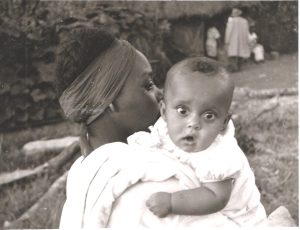Taitu – a Heroic Woman
by Sr. Maureen O’Sullivan MMM (1920 – 2017) Ireland 13.04.2024
Editors Note: This story, first published in 1975, comes from Sr. Maureen’s time in Ethiopia.
 Taitu, one of our patients, was admitted with active, untreated, lepromatous leprosy, in an extremely ill condition. The health worker who informed me of her arrival said she had come with her brother from Tareta in Ticho, and she had also brought her little daughter with her.
Taitu, one of our patients, was admitted with active, untreated, lepromatous leprosy, in an extremely ill condition. The health worker who informed me of her arrival said she had come with her brother from Tareta in Ticho, and she had also brought her little daughter with her.
As I headed in the direction of the out-patients department an avalanche of thoughts swept through my mind. “Tareta, that’s one of Gobessa’s outstation treatment centres. How on earth did she get here? What way did she come? How did she find the way? How long did it take?” I knew that forest, mountain, and gorge lay between Gobessa and Gambo.
How did she come? Presumably on horseback if she was in the condition the health worker described. Horseback and on foot were the only means of travel in these parts. Just as I approached the dispensary, the little group came into view. The sight confirmed the picture my mind had conjured up. Taitu just sat there. Her face was covered with active looking lepromatous nodules, her lips were swollen, and the bridge of her nose somewhat collapsed. She was tired and weak, with hardly any energy to formulate a word. Her right arm encircled her little bundle of a daughter on her knee. She was marasmic and weak, with sunken, dull eyes. Gadisse was about three years old, but her legs were unable to support her little body.
The very evident mutual bond between mother and child was perhaps the only explanation I could see for the child’s survival through the past five-day ordeal of travelling. As I watched the little group during these first moments of negotiation, another scene flashed across my mind’s eye which ha many resemblances to this one. It was of another poor couple, carrying a Child, who were obliged by circumstances to undertake a long and difficult journey into unfamiliar territory. Life in a rural area in developing countries has much akin to what life must have been like in the early Christian era.
After a few preliminaries, Taitu was admitted, and treatment began. Gadisse was also admitted and put in a cot within view of her mother’s bed. Treatment for malnutrition was begun for her, and she was also given preventative treatment against leprosy. Taitu’s brother, after a day’s rest, undertook the long return journey home.
Much water has flown under the bridge since the day Taitu arrived here about two and a half years ago. \\\her case has nor been an easy one and she has had some relapses. Nevertheless, she has never reverted completely to the condition of her arrival. Gadisse now romps happily around, the attraction of all and sundry. Wherever you find her, you know her mother is not too far away. Taitu’s nodules have gone but have left their marks of small localized wrinkled areas in her skin.
Ever a lady to her fingertips, and with an innate sense of refinement, she has not harboured the least trace of bitterness or resentment. The disease has left disfiguring marks on her body, but did nothing to her spirit.
SEE ALL BLOG POSTS
